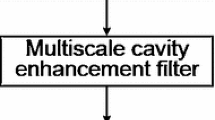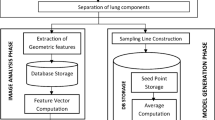Abstract
Segmenting the lungs in medical images is a challenging and important task for many applications. In particular, automatic segmentation of lung cavities from multiple magnetic resonance (MR) images is very useful for oncological applications such as radiotherapy treatment planning. Largely changing lung shapes, low contrast and poorly defined boundaries make the lung cavities hard to be distinguished, even in the absence of prominent neighboring structures. In this paper, we utilized a modified geometric-based snake model which could greatly improve the model’s segmentation efficiency in capturing complex geometries and dealing with difficult initialization and weak edges. This model integrates the gradient flow forces with region constraints provided by fuzzy c-means clustering. The proposed model has been tested on a database of 30 MR images with 80 slices in each image. The obtained results are compared to manual segmentations of the lung provided by an expert radiologist and with those of previous works, showing encouraging results and high robustness of our approach.









Similar content being viewed by others
References
Early Breast Cancer Trialists’ Collaborative Group., Radiotherapy for early breast cancer. Cochrane Database of Systematic Reviews 2002, Issue 2.
Huber, P., Jenne, J., Rastert, R., and Simiantonakis, I., A new noninvasive approach in breast cancer therapy using magnetic resonance imaging-guided focused ultrasound surgery. Cancer Res. 61:8441–8447, 2001.
Evans, P., Donovan, E., and Partridge, M., The delivery of intensity modulated radiotherapy to the breast using multiple static fields. Radiother. Oncol. 57:79–89, 2000. doi:10.1016/S0167-8140(00)00263-2.
Cho, B., Hurkmans, C., Damen, E., and Zijp, L., Intensity modulated versus non-intensity modulated radiotherapy in the treatment of left breast and upper internal mammary lympth node chauin: a comparative planning study. Radiother. Oncol. 62:127–136, 2002. doi:10.1016/S0167-8140(01)00472-8.
Kinhikar, R., Deshpande, S., Mahantshetty, U., and Sarin, R., HDR brachytherapy combined with 3D conformal versus IMRT in left-sided breast cancer patients including internal mammary chain: comparative analysis of dosimetric and technical parameters. J. Appl. Clin. Med. Phys. 6:1–12, 2005. doi:10.1120/jacmp.2025.25344.
Hu, S., Hoffman, E., and Reinhardt, J., Automatic lung segmentation for accurate quantitation of volumetric X-ray CT images. IEEE Trans. Med. Imaging. 20:490–498, 2001. doi:10.1109/42.929615.
Middleton, I., and Damper, R., Segmentation of magnetic resonance images using a combination of neural networks and active contour models. Med. Eng. Phys. 26:71–86, 2004. doi:10.1016/S1350-4533(03)00137-1.
Itai, Y., Kim, H., and Ishikawa, S., A segmentation method of lung areas by using snakes and automatic detection of abnormal shadow on the areas. International Journal of Innovative Computing. Inf. Contr. 3:277–284, 2007.
Silveria, M., Marques, J., Automatic segmentation of the lungs using multiple active contours and outlier model, in: International Conference of the IEEE Engineering in Medicine and Biology, (pp. 3122–3125), 2006.
Brown, M., McNitt-Gray, M., and Mankovich, N., Method for segmenting chest CT image data using an anatomical model: preliminary results. IEEE Trans. Med. Imaging. 16:828–839, 1997. doi:10.1109/42.650879.
Clarke, L., Velthuizen, R., Camacho, M., and Heine, J., MRI segmentation: methods and applications. Magn. Reson. Imaging. 13:343–368, 1995. doi:10.1016/0730-725X(94)00124-L.
Ray, N., Acton, S., Altes, T., Lange, E., and Brookeman, J., Merging parametric active contours within homogeneous image regions for MRI-Based lung segmentation. IEEE Trans. Med. Imaging. 22:189–199, 2003. doi:10.1109/TMI.2002.808354.
Caselles, V., Catte, F., Coll, T., and Dibos, F., A geometric model for active contours. Numerische Math. 66:1–31, 1993. doi:10.1007/BF01385685.
Kass, M., Witkin, A., and Terzopoulos, D., Snakes: Active contour models. Int. J. Comput. Vis. 1:321–331, 1988. doi:10.1007/BF00133570.
Xie, X., and Mirmehdi, M., RAGS: Region-aided geometric snake. IEEE Trans. Image Process. 13:640–652, 2004. doi:10.1109/TIP.2004.826124.
Comaniciu, D., and Meer, P., Mean shift: A robust approach toward feature space analysis. IEEE Trans. Pattern Anal. Mach. Intell. 24:603–619, 2002. doi:10.1109/34.1000236.
Webb, S., The Physics of Medical Imaging. Adam Hilger, Bristol, UK, 1988.
Malladi, R., Sethian, J., and Vemuri, B., Evolutionary fronts for topology independent shape modeling and recovery, in European Conference on Computer Vision (pp. 3–13). Stockholm, Sweden, 1994
Caselles, V., Kimmel, R., and Sapiro, G., Geodesic active contour. Int. J. Comput. Vis. 22:61–79, 1997. doi:10.1023/A:1007979827043.
Kichenassamy, S., Kumar, A., Olver, P., Tannenbaum, A., and Yezzi, A., Gradient flows and geometric active contour models, in International Conference on Computer Vision, (pp. 810–815), Boston, USA, 1995.
Sapiro, G., Color snakes. Comput. Vis. Image Underst. 68:247–253, 1997. doi:10.1006/cviu.1997.0562.
Siddiqi, K., Lauziere, Y., Tannenbaum, A., and Zucker, S., Area and length minimizing flows for shape segmentation. IEEE Trans. Image Process. 7:433–443, 1998. doi:10.1109/83.661193.
Xu, C., and Prince, J., Generalized gradient vector flow external forces for active contours. Signal Processing. 71:131–139, 1998. doi:10.1016/S0165-1684(98)00140-6.
Deng, Y., and Manjunath, B., Unsupervised segmentation of color-texture regions in images. IEEE Trans. Pattern Anal. Mach. Intell. 23:800–810, 2001. doi:10.1109/34.946985.
Pham, D., and Prince, J., Adaptive fuzzy segmentation of magnetic resonance images. IEEE Trans. Med. Imaging. 18:737–752, 1999. doi:10.1109/42.802752.
Xu, C., and Prince, J., Snakes, shapes, and gradient vector flow. IEEE Trans. Image Process. 7:359–369, 1998. doi:10.1109/83.661186.
Bezdek, J., Keller, J., Krisnapuram, R., and Pal, N., Fuzzy Models and Algorithms for Pattern Recognition and Image Processing. Kluwer Academic, Boston, 1999.
Pham, D., Prince, J., Dagher, A., and Xu, C., An automated technique for statistical characterization of brain tissues in magnetic resonance imaging. Int. J. Pattern Recognit. Artif. Intell. 11:1189–1211, 1997. doi:10.1142/S021800149700055X.
Hall, L., Bensaid, A., Clarke, L., Velthuizen, P., Silbiger, M., and Bezdek, J., A comparison of neural networks and fuzzy clustering techniques in segmenting magnetic resonance images of the brain. IEEE Trans. Neural Netw. 3:672–682, 1992. doi:10.1109/72.159057.
Bezdek, J., A convergence theorem for the fuzzy ISODATA clustering algorithms. IEEE Trans. Pattern Anal. Mach. Intell. 2:1–8, 1980.
Sonka, M., Hlavac, V., and Boyle, R., Image Processing, Analysis, and Machine Vision, PWS Publishing, (1999).
Pratt, W., Digital Image Processing. Wiley, New York, 1991.
Rijsbergen, V., Information retrieval. Butterworth, London, 1979.
Author information
Authors and Affiliations
Corresponding author
Rights and permissions
About this article
Cite this article
Osareh, A., Shadgar, B. A Segmentation Method of Lung Cavities Using Region Aided Geometric Snakes. J Med Syst 34, 419–433 (2010). https://doi.org/10.1007/s10916-009-9255-z
Received:
Accepted:
Published:
Issue Date:
DOI: https://doi.org/10.1007/s10916-009-9255-z




